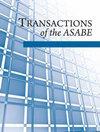土壤-金属滑动阻力模型
IF 1.4
4区 农林科学
Q3 AGRICULTURAL ENGINEERING
引用次数: 1
摘要
HighlightsA模型以正应力和滑动路径长度表示土-金属滑动阻力。土-金属滑动阻力数据,不同于那些用于开发模型,是可接受的模拟。该模型对吸土设备的设计和开发具有一定的指导意义。大多数以前的土-材料滑动阻力研究都集中在测量和表述滑动阻力与材料类型、施加的正应力、滑动路径长度和/或土壤性质之间的定性关系上。很少有研究试图在土-材料滑动阻力与这些因素之间建立定量的数学关系,或者用数学方法表达摩擦和粘着分量对总滑动阻力的相对贡献。在这项研究中,建立了一个数学模型来表示粘土土-金属滑动阻力的组成部分,作为施加的正应力和滑动路径长度的函数。该模型仅限于含有足够水分的土壤,以表现出内聚强度,但没有太多水分表现出总体塑性行为。土壤-金属滑动阻力数据与模型的模拟结果不同,模拟滑动阻力与实测滑动阻力的均方误差在0.653 ~ 2.44之间,模拟结果可以接受。关键词:附着力,摩擦力,正应力,滑动路径长度,滑动阻力。本文章由计算机程序翻译,如有差异,请以英文原文为准。
Modeling Soil-Metal Sliding Resistance
HighlightsA model was developed to express soil-metal sliding resistance in terms of normal stress and sliding path length.Soil-metal sliding resistance data, different from those used to develop the model, were acceptably simulated.The model is expected to be useful in the design and development of soil-engaging equipment.Abstract. Most previous soil-material sliding resistance studies have focused on the measurement and formulation of only qualitative relationships between sliding resistance and the material type, applied normal stress, sliding path length, and/or soil-properties. Few studies have attempted to formulate quantitative mathematical relationships between soil-material sliding resistance and these factors, or to mathematically express the relative contributions of the frictional and adhesive components to the total sliding resistance. In this study, a mathematical model was developed to express the components of soil-metal sliding resistance for a clay soil as functions of applied normal stress and sliding path length. The model is restricted to soil containing enough moisture to exhibit cohesive strength, but not so much moisture to exhibit gross plastic behavior. Soil-metal sliding resistance data, different from those used to develop the model, were acceptably simulated, as the mean square error between the simulated sliding resistance and the measured sliding resistance ranged from 0.653 to 2.44. Keywords: Adhesion, Friction, Normal stress, Sliding path length, Sliding resistance.
求助全文
通过发布文献求助,成功后即可免费获取论文全文。
去求助
来源期刊

Transactions of the ASABE
AGRICULTURAL ENGINEERING-
CiteScore
2.30
自引率
0.00%
发文量
0
审稿时长
6 months
期刊介绍:
This peer-reviewed journal publishes research that advances the engineering of agricultural, food, and biological systems. Submissions must include original data, analysis or design, or synthesis of existing information; research information for the improvement of education, design, construction, or manufacturing practice; or significant and convincing evidence that confirms and strengthens the findings of others or that revises ideas or challenges accepted theory.
 求助内容:
求助内容: 应助结果提醒方式:
应助结果提醒方式:


